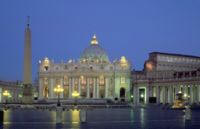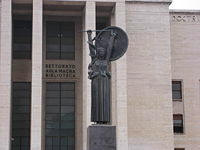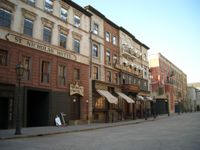|
вырос
построены
современник
связанный |
Religion
The Religio Romana constituted the major religion of the city in
antiquity. However, several other religions and imported mystery
cults remained represented within its ever-expanding boundaries,
including Judaism, whose presence in the city dates back from the
Roman Republic and was sometimes forcibly confined to the Roman
Ghetto, as well as Christianity. Despite initial persecutions, by
the early 4th century, Christianity had become so widespread that it
was legalized in 313 by Emperor Constantine I, and later made
official religion of the Roman Empire in 380 by Emperor Theodosius
I, allowing it to spread further and eventually wholly replace the
declining Religio Romana.
Rome became the pre-eminent Christian city (vis-a-vis Antioch and
Alexandria, and later Constantinople and Jerusalem) based on the
tradition that Saint Peter and Saint Paul were martyred in the city
during the 1st century, coupled with the city's political
importance. The Bishop of Rome, later known as the Pope, claimed
primacy over all Bishops and therefore all Christians on the basis
that he is the successor of Saint Peter, upon whom Jesus built his
Church; his prestige has been enhanced since 313 through
donations by Roman emperors and patricians, including the Lateran
Palace and patriarchal basilicas, as well as the obviously growing
influence of the Church over the failing civil imperial authority.
Papal authority has been exercised over the centuries with varying
degrees of success, at times triggering divisions among Christians,
until the present.

St. Peter's Square in the early morning.
With the increasing chaos and disorder leading to the collapse of
the Roman Empire in 476, the popes assumed more and more civil
authority first in Rome and in the surrounding territories. Rome
became the center of the Catholic Church and the capital city of the
Papal States; consequently, a great number of churches, convents and
other religious buildings were erected in the city, sometimes
above the ruins of older pre-Christian sites of worship. Churches
proliferated during the Renaissance, when the Rome's most notable
churches were built (this includes St. Peter's basilica on the
Vatican Hill (the largest church in the world) and the city
cathedral of St. John at the Lateran. The Papacy established its
residence first in the Lateran Palace, then in the Quirinal Palace.
When Rome was annexed by force to the newly unified Kingdom of Italy
In 1870, Pope Pius IX retired to the Vatican, proclaiming himself a
prisoner of the Savoy monarchy and leading to decades of conflict
between the neonate state and the Catholic Church. This was resolved
in 1929, when the Lateran Treaty were signed in Rome, establishing
the right for the Holy See to govern the Vatican City as an
independent, sovereign state. The patron saints of Rome remain Saint
Peter and Saint Paul (or, as they are collectively referred to in
this context, "the most holy Saints Peter and Paul"), both
celebrated on June 29.

Central mosque by Paolo Portoghesi, Rome (1974)
In recent years, the Islamic community has grown significantly, in
great part due to immigration from North African and Middle Eastern
countries into the city. As a consequence of this trend, the comune
promoted the building of the largest mosque in Europe, which was
designed by architect Paolo Portoghesi and inaugurated on June 21,
1995.
Language
The original language of Rome was Latin, which evolved during the
Middle Ages into Italian. The latter emerged as the confluence of
various regional dialects, among which the Tuscan dialect
predominated, but the population of Rome also developed its own
dialect, the Romanesco. The ancient romanesco, used during the
Middle Ages, was a southern Italian dialect, very close to the
Neapolitan. The influence of the Florentine culture during the
renaissance, and, above all, the immigration to Rome of many
florentines who were among the two Medici Popes' (Leo X and Clement
VII) suite, caused a strong change of the dialect, which became much
closer to the Tuscan varieties. This remained largely confined to
Rome until the 19th century, but then expanded other zones of Lazio
(Civitavecchia, Latina), from the beginning of the 20th century,
thanks to the rising population of Rome and to better transportation
systems. As a consequence, Romanesco abandoned its traditional forms
to mutate into the dialect spoken within the city, which is more
similar to standard Italian, although remaining distinct from other
Romanesco-influenced local dialects of Lazio. Dialectal literature
in the traditional form Romanesco includes the works of such authors
as Giuseppe Gioacchino Belli, Trilussa, and Cesare Pascarella.
Contemporary Romanesco is mainly represented by popular actors
such as Aldo Fabrizi, Alberto Sordi, Nino Manfredi, Anna Magnani,
Gigi Proietti, Enrico Montesano, and Carlo Verdone.

The statue of Minerva in La Sapienza University
Universities
Rome is a nation-wide center for higher education. Its first
university, La Sapienza (founded in 1303), is the largest in Europe
and the second largest in the World, with more than 150,000 students
attending.[citation needed] Two new public universities were
founded: Tor Vergata in 1982, and Roma Tre in 1992, although the
latter has now become larger than the former. Rome also contains a
large number of pontifical universities and institutes, including
the Pontifical Gregorian University (The oldest Jesuit university in
the world, founded in 1551), the Angelicum university, and many
others. The city also hosts various private universities, such as
the LUMSA, the Università Cattolica del Sacro Cuore (Roman centre),
the LUISS, Istituto Europeo di Design the John Cabot University, the
IUSM, the American University of Rome,the Link Campus of Malta, the
S. Pio V University of Rome, and the Università Campus Bio-Medico.
Rome is also the location of the John Felice Rome Center, a campus
of Loyola University Chicago.
Music

The main auditorium in the Parco della Musica,
designed by Renzo Piano.
Rome is an important center for music. It hosts the Accademia
Nazionale di Santa Cecilia (founded in 1585), for which new concert
halls were recently built in the new Parco della Musica, one of the
largest musical venues in the world. Rome also has an opera house,
the Teatro dell'Opera di Roma, as well as several minor musical
institutions. The city also played host to the Eurovision Song
Contest 1991 and the MTV Europe Music Awards 2004.
Cinema

Set of Gangs of New York in Cinecittà studios, Rome
Rome hosts the Cinecittà Studios, that are the center of the Italian
cinema, and many of today's biggest box office hits are filmed
there. Many consider it synonymous with Italian cinema in general.
Founded in 1937 by Fascist dictator Benito Mussolini, the studios
were bombed by the Western Allies during World War II. In the 1950s,
Cinecittà was the filming location for several large American film
productions like Ben-Hur, and then became the studio most closely
associated with Federico Fellini.
After a period of near-bankruptcy in the 1980s, Cinecittà was
privatized by the Italian government.
In recent years, Cinecittà was chosen by director Martin Scorsese as
the filming location for his Gangs of New York. Wes Anderson's The
Life Aquatic with Steve Zissou and HBO Rome Tv seires was also shot
at Cinecittà.
|